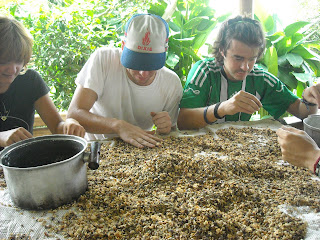I had a late last night in America that consisted of a posse
of Tarheel alumni taking on Williamsburg, Brooklyn in formal
attire (Williamsburg is a hipster hub; we had on slacks and vests whilst being surrounded by flatbill hats, mustaches, and thick framed nonprescription
glasses). The night included me getting a drink poured on my head by a girl for
air guitaring the Van Halen solo from ‘Beat It’ in the face of her boyfriend
who called our crew awkward, and although the bouncer found it funny I was
asked to leave, because they were both apparently regulars, and I was but a
mere North Carolinian in transit (luckily the drink was clear, so really it just sterilized my hair).
After waking up surprisingly un-hungover, I hopped on the
metro to get to JFK airport, and then waited for 2 hours. When I arrived in Milan
after an 8 hour flight, the hallway of the airport had a perfect view of an
amazing sunrise over the Alps. Too strung out, I failed to get a picture. I
waited in Milan, amongst many Milanese for my next flight—they reminded me
of well-bred versions of the Jersey Shore folk, with a little higher
clothing budget and less steroids.
After another 6 hour flight I was in Bahrain, which is when it started becoming apparent that I wasn’t in Kansas anymore; there were many
forms of man-dresses—some white, some brown, others decorated, but all of them were remarkably clean. There were quite a few women in Hijabs, which I can’t say I have ever seen more than one or two of at a time. There were also a bunch of Indian folks head bobbling to each other. I’m sure I
will have more to say about this ‘head bobble’ as I see more of it in action,
but for the time being, youtube it. It apparently means yes, no, hi, maybe, as
well as more nuanced and elegant ‘fuck-offs’ or other things in certain
situations. One Indian guy seemed to ask one of his South Asian brethren to
watch his suitcase, which received a head bobble response; 2 minutes later, this dude left the suitcases unattended (maybe that time it meant ‘yeah sure, but
only for 2 minutes’).
I also met a self-proclaimed Miami club promoter of
Pakistani descent who was going back home to meet a candidate for his arranged
marriage. He claimed to have been born and raised in The States, but he had
weird gaps in his English, made strange cultural references, and started
showing me pseudo-red-carpet photos of girls that he had allegedly hooked up
with. Then he went and changed into a man dress—all this aggregated to make me
believe he was a spy, but I don’t think there is much espionage work to be had in
Miami, so who knows.
After finally
shedding him (he was a stage 2 clinger), I picked up an Arabic magazine that
was sitting next to my seat. There was a section on staying fit in urban areas; the first suggestion was washing more vigorously in the shower, because it burns more
calories. I also noticed a Chili’s, where instead of whatever kind of art a
Chili’s has at home, there were pictures of the handsome,
mustached members of Bahrain’s royal family.
I arrived in Mumbai after yet another flight. At this point
my body didn’t know what to think; it was day time, and I hadn’t slept in God
knows how long. After finally being let into the concourse, I decided to just
get coffee and try to hold out for a bed later that night in Thailand. An older
gentleman was brought over next to me in a wheelchair. The coffee and 2 all-nighters had me feeling chatty,
so I struck up a conversation.
Come to find out, this guy, Ken, was shot in the head in the
Vietnam War. After waking up in San Francisco weeks later he was left without
the use of his right side, his speech faculties, and his reading and writing
ability. All he could say was ‘great,’ but he didn’t know it—he thought he was
still speaking fluent English. After months of speech therapy he started getting his
language back, and he battled the next 10 years to reteach himself to read. His
writing is still heavily impaired, partially because he was right-handed, and his vision has been cloudy since the injury.
Since then, Ken has been hoarding his disability checks and
spending 5 months a year in Thailand; his extended passport included pages upon
pages of Thai visas. He told me that after spending 10 years going back and
forth to Thailand that he felt he was “A Master of Southeast Asia.” So I’m
figuring from this that he speaks Thai, lives in a teak hut, and drinks
rice whiskey in the Northern Jungles with people that have never seen a car,
but apparently his definition of 'Master' differs from mine. Come to find out,
he speaks no Thai, uses a travel agent, and his only two suggestions for places to go were Pattaya and Patong, which
I later found out are the first and second largest sex tourism hubs in
Thailand.
I arrived in Bangkok after another 5 hour flight, took the
metro to a hostel, and passed out for the next 12 hours. I woke up feeling like
a refreshed ‘Master of Southeast Asia’ and ready to take on crazy-ass Bangkok.





























